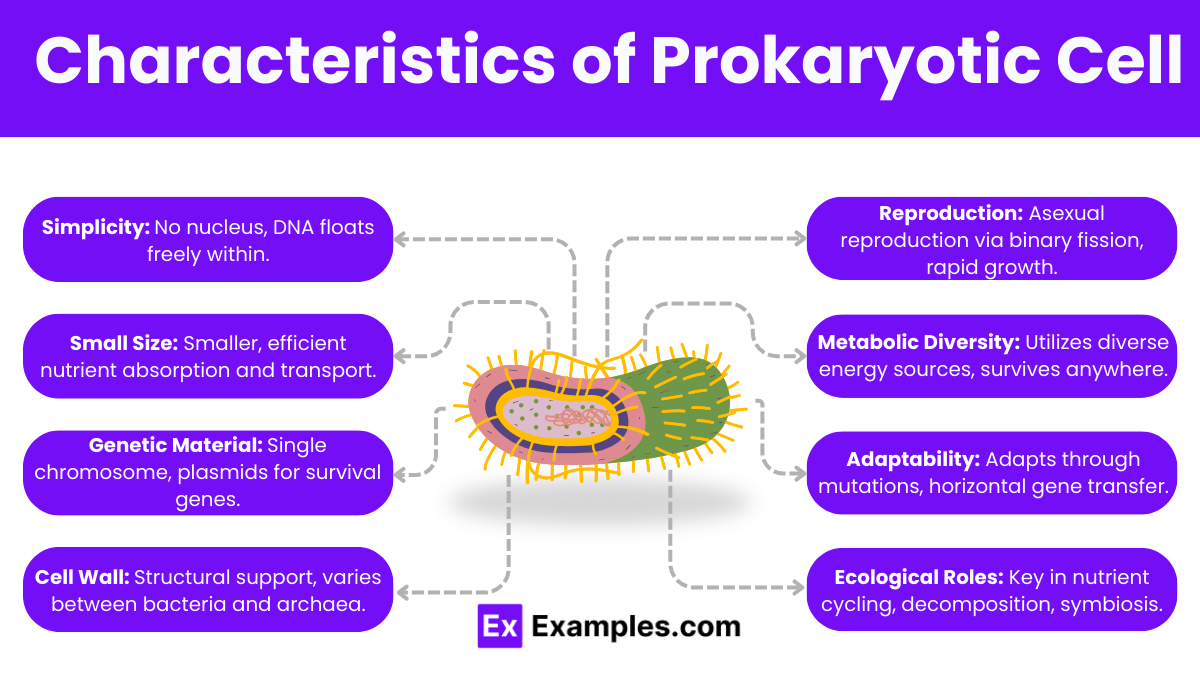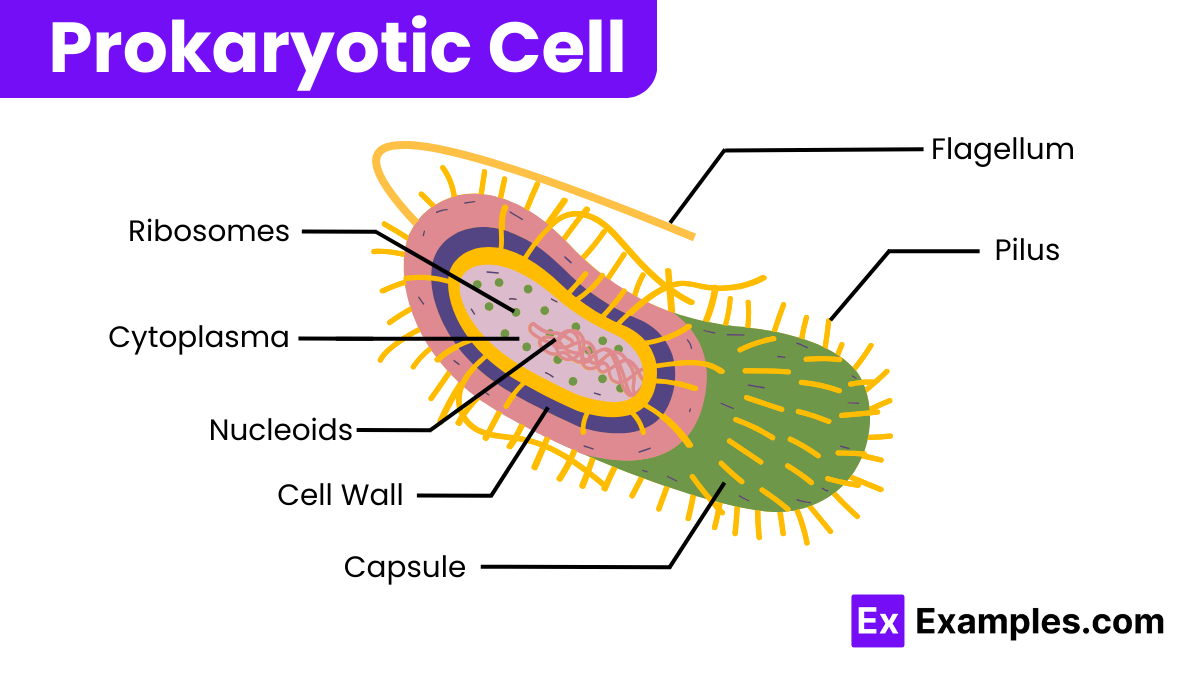Which of the following is a characteristic of prokaryotic cells?
Presence of a nucleus
Presence of membrane-bound organelles
Lack of a true nucleus
Presence of a mitochondrion

Prokaryotic cell, characterized by their lack of a nucleus and simpler internal structure compared to eukaryotic cells, play crucial roles in various biological processes and ecosystems. From bacteria to archaea, these cells exhibit remarkable diversity and capabilities. Through real-world examples, learn about their structure, function, and the vital contributions they make to environmental balance, medical advancements, and biotechnology. This guide promises a deep understanding of prokaryotic cells, making it an essential read for students, educators, and science enthusiasts alike. Uncover the secrets of these tiny yet mighty entities and their significant impact on our world.
A prokaryotic cell is a simple, single-celled organism without a nucleus or other membrane-bound organelles. Its DNA floats freely within the cell, and it is characterized by its small size and simplicity. Prokaryotes include bacteria and archaea, playing essential roles in ecosystems, such as decomposition and nitrogen fixation. Unlike eukaryotic cells, prokaryotes reproduce through a process called binary fission, allowing for rapid growth and adaptation to environmental changes.

Prokaryotic cells, encompassing the vast domains of Bacteria and Archaea, are the most ancient and numerous forms of life on Earth. Their characteristics define not only their biological functions but also their crucial roles in ecosystems and various industries. Understanding these characteristics is essential for appreciating the complexity of life and the fundamental differences between prokaryotic and eukaryotic organisms. This comprehensive guide delves into the unique features of prokaryotic cells, highlighting their structure, genetic makeup, and ecological importance, optimized for clarity and accessibility.

Exploring the structure of prokaryotic cells unveils the fascinating simplicity and efficiency that underpin these microscopic entities. Prokaryotic cells, the oldest forms of life on Earth, are distinguished by their lack of a defined nucleus and simplicity compared to their eukaryotic counterparts. This comprehensive guide delves into the structural components that characterize prokaryotic cells, highlighting their functionality and significance in various biological processes and ecosystems.
The cell membrane, a fundamental component of all living cells, is particularly crucial in prokaryotes. It consists of a phospholipid bilayer embedded with proteins, serving as a selective barrier. This membrane controls the passage of substances in and out of the cell, ensuring the maintenance of a stable internal environment—a process known as homeostasis. The fluid mosaic model best describes its dynamic nature, with proteins moving within the lipid bilayer to perform various functions, such as transport, communication, and catalysis.
Within the confines of the cell membrane lies the cytoplasm, a jelly-like substance that houses the cell’s genetic material and ribosomes. This matrix is the site of numerous biochemical reactions essential for the cell’s survival and replication. It provides a medium for the distribution of nutrients, enzymes, and other vital components throughout the cell.
Unlike eukaryotic cells, prokaryotic cells do not possess a membrane-bound nucleus. Instead, their genetic material, typically a single, circular chromosome, is located in a region of the cytoplasm called the nucleoid. This DNA contains all the information necessary for the cell’s functions and reproduction. The nucleoid’s open structure allows for direct access to genetic information, facilitating rapid transcription and translation processes.
Ribosomes are essential for protein synthesis in all living cells, and prokaryotic cells are no exception. Prokaryotic ribosomes, though smaller than their eukaryotic counterparts, play a pivotal role in translating mRNA into polypeptide chains. These ribosomes are dispersed throughout the cytoplasm, underscoring the cell’s dedication to efficient protein production.
Most prokaryotic cells boast a cell wall that encases the cell membrane. This rigid structure provides mechanical support and protection, preventing the cell from bursting in hypotonic environments. Bacteria typically have a cell wall made of peptidoglycan, a complex molecule providing strength and rigidity. Archaea, on the other hand, have cell walls composed of distinct molecules like pseudopeptidoglycan, reflecting their adaptation to various environments.
Some prokaryotic cells have an additional layer outside the cell wall known as the capsule. Made of polysaccharides, this gelatinous coat aids in protecting the cell from desiccation and phagocytosis. Furthermore, the capsule plays a crucial role in the cell’s ability to adhere to surfaces and evade the host’s immune system, making it a key factor in the virulence of pathogenic bacteria.
For mobility, many prokaryotic cells possess flagella—long, whip-like structures that rotate to propel the cell through its environment. Additionally, pili are shorter, hair-like appendages that facilitate attachment to surfaces and other cells. Pili also play a significant role in the exchange of genetic material during processes like conjugation, contributing to genetic diversity and adaptability.
Prokaryotic cells, which are simpler and smaller than eukaryotic cells, are characterized by their lack of a nucleus and membrane-bound organelles. They are typically found in bacteria and archaea. The main components of a prokaryotic cell include.
Reproduction in prokaryotes is primarily asexual, meaning it occurs without the fusion of gametes, and results in offspring that are genetically identical to the parent organism. The most common form of reproduction in prokaryotes is binary fission, but other mechanisms such as budding, filamentation, and the formation of spores also occur in specific conditions or species. Additionally, prokaryotes can exchange genetic material through processes like conjugation, transformation, and transduction, which, while not reproductive methods per se, contribute significantly to genetic diversity and evolution. Here’s a closer look at these processes:
Binary fission is a straightforward form of asexual reproduction and cell division in prokaryotes, characterized by the following steps:
Though not forms of reproduction, these mechanisms significantly impact genetic diversity and evolution in prokaryotes:
Prokaryotic vs eukaryotic cells represent the two primary cell types in the biological world, differing mainly in complexity. Prokaryotic cells, found in bacteria and archaea, are simpler, lacking a nucleus and membrane-bound organelles, with their genetic material freely floating in the cytoplasm. In contrast, eukaryotic cells, which make up plants, animals, fungi, and protists, have a defined nucleus that houses their DNA and possess various specialized organelles, enabling them to carry out complex functions. These structural differences fundamentally affect their functions, reproduction, and roles in the ecosystem.
Prokaryotic cells encompass a vast and diverse group of organisms, primarily classified into two domains: Bacteria and Archaea. Here are examples from each domain, highlighting their unique characteristics and ecological roles:
Escherichia coli (E. coli): A widely studied bacterium found in the intestines of humans and other warm-blooded animals. While most strains are harmless and contribute to the gut microbiota, some can cause food poisoning and serious infections. E. coli serves as a key model organism in biotechnology and genetics.
Streptococcus pneumoniae: This bacterium is a significant human pathogen, causing pneumonia, meningitis, and otitis media (middle ear infection). Its ability to develop resistance to antibiotics underscores the importance of ongoing research and vaccine development.
Cyanobacteria (Blue-green algae): These photosynthetic bacteria are crucial for life on Earth, producing oxygen through photosynthesis similar to plants. They play a key role in nitrogen fixation and form the base of many aquatic food webs.
Halophiles: These Archaea thrive in extremely salty environments, such as salt lakes and evaporation ponds. Halophiles are of interest for their unique biochemical processes and potential applications in biotechnology, such as enzymes that function in high salt concentrations.
Thermophiles: Found in hot environments like hot springs and hydrothermal vents, thermophiles can survive at temperatures exceeding 80°C. Their enzymes are highly stable at high temperatures, making them valuable for industrial processes, including the polymerase chain reaction (PCR) technique.
Methanogens: Methanogens produce methane as a metabolic byproduct under anaerobic conditions. They are found in environments like wetlands, ruminant stomachs, and anaerobic digesters. Methanogens are essential for the decomposition of organic matter and are used in biogas production
Prokaryotic cells reproduce asexually through binary fission, a process where the cell divides into two identical daughter cells, ensuring rapid population growth.
Prokaryotic cells are generally smaller than eukaryotic cells, typically ranging from 0.1 to 5.0 micrometers in diameter, allowing for efficient nutrient uptake and waste removal.
Yes, prokaryotic cells contain DNA. Their genetic material is not enclosed in a nucleus but is found in the cytoplasm, usually in a single circular chromosome.
Many prokaryotic cells can move using structures like flagella or cilia. These appendages propel them through their environment, aiding in food search and escape from predators.
Prokaryotic cells, embodying simplicity and efficiency, are the ancient architects of life on Earth. Characterized by their lack of a nucleus and simpler structures, these cells thrive in diverse environments, contributing significantly to ecosystems and biotechnology. Their study not only sheds light on life’s origins but also paves the way for advancements in medicine and environmental management.
Text prompt
Add Tone
Prokaryotic vs Eukaryotic Cells
Examples of Prokaryotic cell
Which of the following is a characteristic of prokaryotic cells?
Presence of a nucleus
Presence of membrane-bound organelles
Lack of a true nucleus
Presence of a mitochondrion
Which of the following organisms are prokaryotes?
Plants
Animals
Bacteria
Fungi
What is the function of the cell wall in prokaryotic cells?
To generate energy
To provide structural support and protection
To synthesize proteins
To replicate DNA
Which of the following is NOT found in prokaryotic cells?
Ribosomes
Plasma membrane
Nucleus
Cytoplasm
Prokaryotic cells reproduce by:
Mitosis
Meiosis
Binary fission
Budding
The genetic material in a prokaryotic cell is:
Linear DNA within a nucleus
Circular DNA within a nucleoid
RNA within the cytoplasm
Double-stranded RNA within a mitochondrion
Which structure allows prokaryotic cells to move?
Cilia
Flagella
Pseudopodia
Microvilli
What is the main component of the prokaryotic cell wall?
Cellulose
Chitin
Peptidoglycan
Glycoproteins
Prokaryotic cells can exchange genetic material through:
Transformation
Transduction
Conjugation
All of the above
Which of the following structures is involved in protein synthesis in prokaryotic cells?
Mitochondria
Ribosomes
Golgi apparatus
Endoplasmic reticulum
Before you leave, take our quick quiz to enhance your learning!

